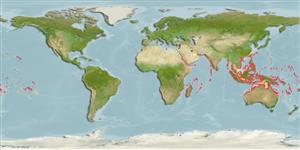Common names from other countries
Classification / Names / Names
Nomi Comuni | Sinonimi | Catalog of Fishes (gen., sp.) | ITIS | CoL | WoRMS
Environment: milieu / climate zone / depth range / distribution range
Ecologia
Associati a barriera corallina; non migratori (Ref. 348); salmastro; distribuzione batimetrica 0 - 35 m (Ref. 348). Tropical; 23°C - 30°C (Ref. 102835); 28°N - 37°S, 31°E - 128°W
Indo-Pacific: Egypt to Pitcairn Islands and Ogasawara, Japan to Lord Howe Island.
Length at first maturity / Size / Peso / Age
Maturity: Lm ?, range 6 - 13 cm Max length : 41.7 cm SHL maschio/sesso non determinato; (Ref. 117184); common length : 25.0 cm SHL maschio/sesso non determinato; (Ref. 348)
The mantle color is highly variable, ranging from bright blue to brown.
Collected for food and for the shell trade. Aquaculture trials have been done in 1998 (Ref. 348). Maximum depth from Ref. 75831. Found in coral reef flats in shallow areas (Ref. 799), reef areas of lagoons (Ref. 97298) and in intertidal areas (Ref. 75831). Mixotrophic - filter feeds and photosynthesizes via its zooxanthellae (Ref. 105208). Tridacnids derive their nutrition from uptake of dissolved matter through their epidermis and from their symbiotic zooanthella Symbiodinium microadriaticum (Ref. 107098).
Life cycle and mating behavior
Maturità | Riproduzione | Deposizione | Uova | Fecundity | Larve
Life cycle: Embryos develop into free-swimming trocophore larvae, succeeded by the bivalve veliger, resembling a miniature clam (Ref. 833).
SAUP Database. 2006. (Ref. 356)
IUCN Red List Status (Ref. 130435)
CITES status (Ref. 108899)
Not Evaluated
Threat to humans
Reports of ciguatera poisoning (Ref. 130160)
Human uses
Pesca: commerciale
FAO - Acquacoltura: production; | FishSource | Sea Around Us
Strumenti
Fonti Internet
Estimates based on models
Preferred temperature
(Ref.
115969): 24.8 - 29.3, mean 28.4 (based on 3421 cells).
Resilienza
Medio, tempo minimo di raddoppiamento della popolazione 1.4 - 4.4 anni (K=0.18-0.28; tm=3.8).
Prior r = 0.49, 95% CL = 0.32 - 0.73, Based on 1 data-limited stock assessment.
Vulnerability
Low vulnerability (25 of 100).
Price category
Unknown.
